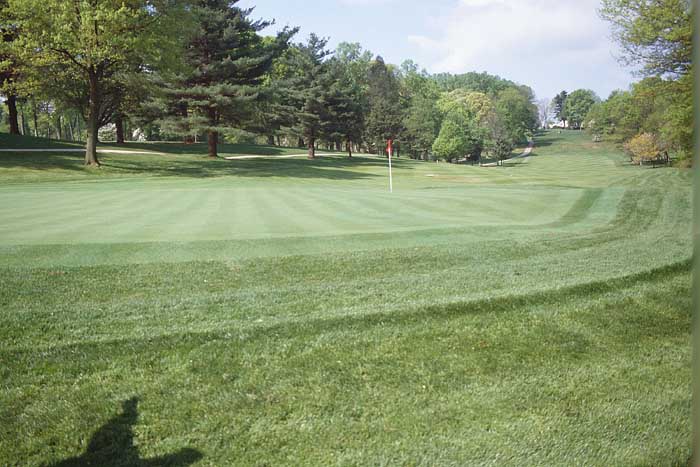mayday;
I'm going to "cheat" in responding to you by using Ran's words on the HV course description on this site, and then offer a bit myself;
"..., the course has a consistent theme to it: the great majority of greens are canted from one side to the other. It doesn't take long to figure out that one cannot have a decent score at Huntingdon Valley by consistently missing the greens on the high side. This feature is so refreshing (refreshing for a 65+ year-old course?!?) compared to the predictable back-to-front slope on so many greens on many courses. In fact, the authors wonder if Tom Doak and Gil Hanse borrowed this concept from HVCC for their own Stonewall just west of Philadelphia. At Stonewall almost every green has a definite high side. Players can use these slopes to their advantage or have these slopes make for a very long round. It is infinitely more enjoyable to aim left or right of the hole and watch the green move the ball toward the hole than continually face the same question asked by back-to-front sloping greens."
"Third, as noted by David Eger, 1988 Mid-Amateur Champion, the course keeps the player on edge with few level stances in the fairway. However, the slopes are fairly subtle so that the player is not hit over the head with this characteristic. Special note needs to be paid to Green Keeper Scott Anderson and to the Club for their approach to course conditioning. They pride themselves on having the firmest, fastest course in the Philadelphia area (this includes Merion) and are not afraid to see a little brown on the course. Hundreds and hundreds of parkland courses need to follow in their footsteps across the country. As is clearly demonstrated at Huntingdon Valley, firm courses provide for far more thoughtful shotmaking as the player must think about where he wants to land each shot. The player is forced to appreciate the land more and as the Green Comittee chairman remarked, 'The land is your friend here.'"
"To top it off, the course has the requisite Flynn attributes: excellent bunkering, often dug into the sides of hills; beautifully-framed green sites and interesting recovery shots to varied greens."
Mayday, I'd just add to that that the "high sides" that Ran talked about are maintained as fairway. I see too many clubs (Flynn and otherwise) taking away these valid approaches by growing thick rough on the high-side, or worse yet,
combining that with evergreen tree planting along the high-side slope (think #7 at RG), thereby eliminating the running shot.
Think about how cool #5 at Merion, for instance, would be if the fairway was restored to it's original width, with the fairway coming up to and behind the bunker that fronts the right portion of the green! One would be able to flirt with that bunker and if successful, use the slope to work the ball onto the green.
The following pic from behind the 2nd hole at HV is illustrative. If one flirts with the bunker (that's short of the green but in the "perfect" spot...seen in this picture as a grassy hump from behind) successfully, the fairway cut beyond accommodates the running approach on the longish par four.

That's the kind of symbiotic relationship between architectural intent and maintenance practices that I like to see, and it's exhibited in spades at Huntingdon Valley.
Contrast that maintenance approach with the following hole you might be familiar with and I think you'll see the difference!

